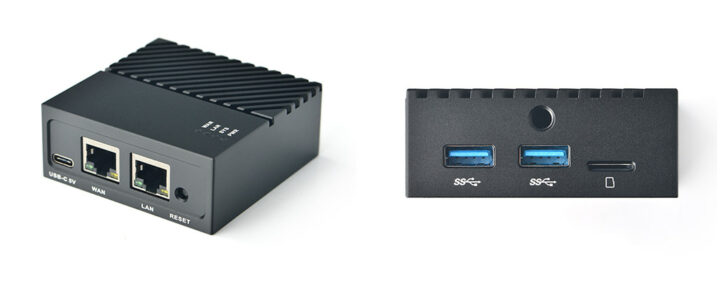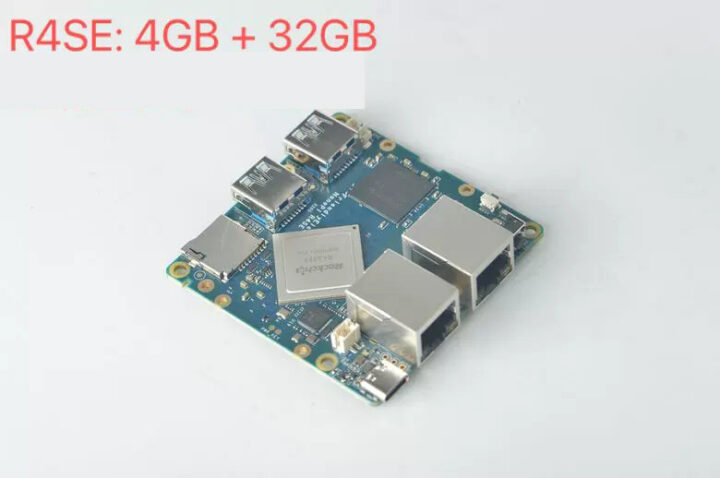NanoPi R4SE is a variant of the Rockchip RK3399-powered NanoPi R4S dual Gigabit Ethernet router that adds a 32GB eMMC flash instead of only relying on a microSD card for the operating system.
Most of the specifications remain the same with dual GbE, two USB 3.0 ports, but the router is now only offered with 4GB LPDDR4 and there’s no option for only 1GB RAM, and the GPIO and USB 2.0 headers are gone. The listed temperature range also changed from -20°C to 70°C to 0°C to 80°C.

NanoPi R4SE specifications:
- SoC – Rockchip RK3399 hexa-core processor with dual-Core Cortex-A72 up to 2.0 GHz, quad-core Cortex-A53 up to 1.5 GHz, Mali-T864 GPU with OpenGL ES1.1/2.0/3.0/3.1, OpenCL, DX11, and AFBC support, 4K VP9 and 4K 10-bit H265/H264 60fps video decoder
- System Memory – 4GB LPDDR4
- Storage – 32GB eMMC flash, MicroSD card slot
- Networking – 2x GbE, including one native Gigabit Ethernet, and one PCIe Gigabit Ethernet
- USB – 2x USB 3.0 Type-A ports,
USB 2.0 via 4-pin header Expansion – 2x 5-pin header with 1x SPI, 1x I2C- Debugging – 3-pin debug UART header (1,500,000 bps by default)
- Misc- 1x power LED, and 3x user LEDs (SYS, LAN, WAN), user button, 2-pin RTC battery connector, 5V fan connector, one MASK button for eMMC update
- Power Supply
- 5V/3A via USB-C connector
- RK808-D PMIC and independent DC/DC enabling DVFS, software power-down, RTC wake-up, system sleep mode
- Dimensions – 66 x 66 mm (8-layer PCB); enclosure: 72 x 72 x 29 mm
- Temperature Range – -0°C to 80°C
We don’t have the usual pretty photos from FriendlyELEC since the Wiki is still a work in progress. We wrote an early NanoPi R4S review with OpenWrt and Ubuntu Core in December 2020, but the company appears to mainly focuses on OpenWrt and supports Docker CE.
While looking at the wiki for the earlier R4S, I also noticed FriendlyELEC now has NanoPi R4S Standard and Enterprise versions with the latter adding a built-in EEPROM chip (24AA025E48T) to store a globally unique MAC address. The standard version lacks this chip and generates a MAC address by software at boot time. There’s no mention of EEPROM for the NanoPi R4SE, but that would be nice if it would be included in all boards since it could potentially cause issues for people with multiple FriendlyELEC routers in a LAN. [Update: It turns out the reason for the lack of EEPROM is… supply shortage:
Due to the shortage of the chip that has a unique built-in MAC address, we no longer list the R4S board with a unique MAC address for retail sales. If you want to order the R4S board with a unique MAC address, you have to place an order with a minimum order quantity of 100 pieces
]
FriendlyELEC is not selling the router or SBC just yet, but should soon in a few days, and we noticed the NanoPi R4SE from sellers on Aliexpress offering the complete router for $85.99 plus shipping (“RS4E-4GB-32GB EMMC” option). There are also bundles with a 5V/3A or 5V/4A power supply for $91.99 and $98.99 respectively. [Update: FriendlyELEC does list NanoPi R4SE on the NanoPi RS4 store page, and sells it for $70]
Thanks to theguyuk for the tip.

Jean-Luc started CNX Software in 2010 as a part-time endeavor, before quitting his job as a software engineering manager, and starting to write daily news, and reviews full time later in 2011.
Support CNX Software! Donate via cryptocurrencies, become a Patron on Patreon, or purchase goods on Amazon or Aliexpress. We also use affiliate links in articles to earn commissions if you make a purchase after clicking on those links.





You will find the NanoPi R4SE as a +$ 20 option on the NanoPi R4S page, as well as a mention of chip shortage affecting unique MAC address, still available on orders of 100 +
All network gear needs a fixed, unique MAC address. Period. The end.
I guess you have never heard of MAC randomization.
In practice, a MAC address needs to be unique only within your switched LAN.
Two separate network segments which are accessible only via L3 routing are not even aware of the other segment’s MAC addresses.
MAC randomization is designed to promote privacy. I took a survey and the gear running my network isn’t interested in privacy but thanks for asking.
Really https://source.android.com/devices/tech/connect/wifi-mac-randomization#:~:text=In%20Android%2010%2C%20MAC%20randomization,and%20Wi%2DFi%20RTT%20operations.
In practice no, it’s just to provide connectivity that will not cause conflicts with other devices lacking a fixed MAC address as well. Then, some are able to store it, others not.
And still no externally accessible console port 🙁 It’s really too bad, because the device is great but basically unusable in production and unusable for network engineers/consultants.
It’s *only* missing this to be usable as a good alternative to the Clearfog. A $0.50 CH340E and a micro-usb connector, which could even be placed on the opposite side (“front”) for more convenient access when installed on a rack.
In fact the EEPROM of unique MAC address was a standard configuration and equipped on ALL R4S sold before. The new “enterprise” and “standard” configurations are introduced for cost-down reasons.
FriendlyELEC also mentions having trouble sourcing the EEPROM, so that’s why they introduced a configuration without one… See theguyuk comments and post updates.
Good choice 4 tin cluster experiments.
yes for small clusters such machines are excellent. You can easily connect 4 of them to a cheap 5-port gig switch and start to do a lot of fun stuff. They’re much easier to use than the NEO4 that had no enclosure by then!